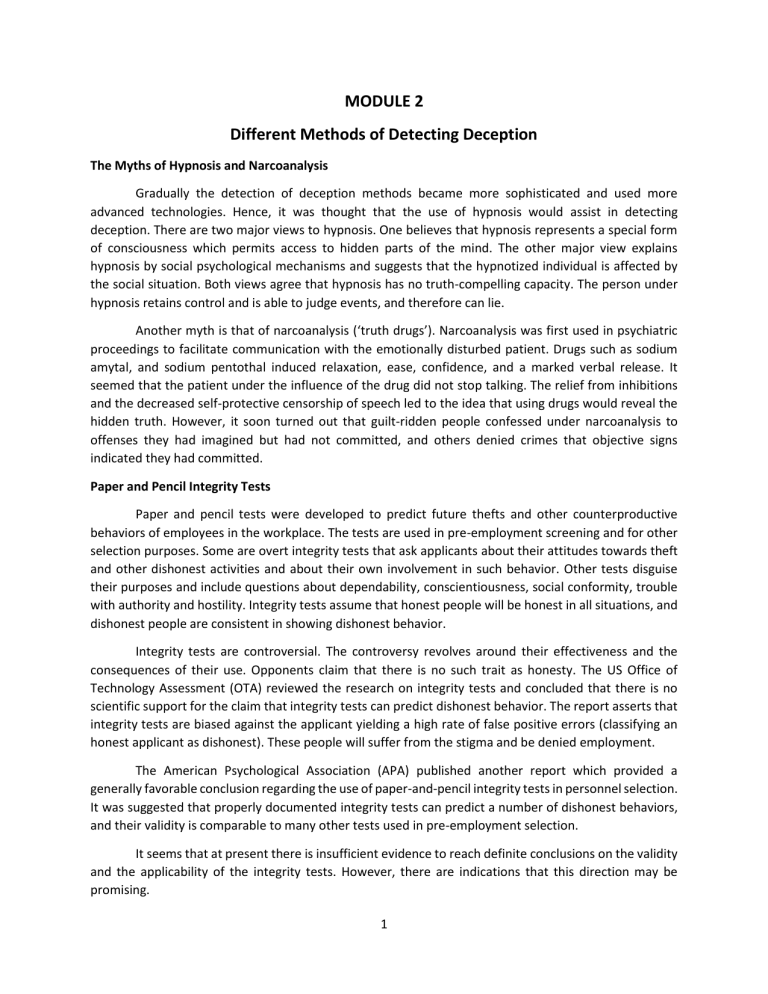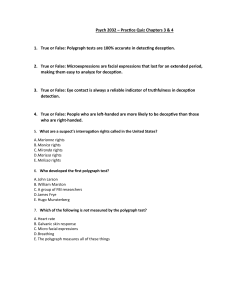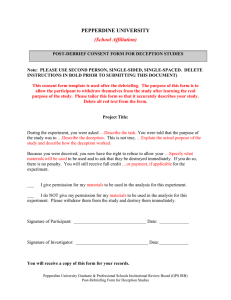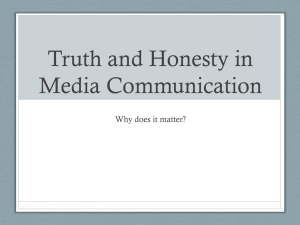Deception Detection Methods: Hypnosis, Polygraph, and More
advertisement

MODULE 2 Different Methods of Detecting Deception The Myths of Hypnosis and Narcoanalysis Gradually the detection of deception methods became more sophisticated and used more advanced technologies. Hence, it was thought that the use of hypnosis would assist in detecting deception. There are two major views to hypnosis. One believes that hypnosis represents a special form of consciousness which permits access to hidden parts of the mind. The other major view explains hypnosis by social psychological mechanisms and suggests that the hypnotized individual is affected by the social situation. Both views agree that hypnosis has no truth-compelling capacity. The person under hypnosis retains control and is able to judge events, and therefore can lie. Another myth is that of narcoanalysis (‘truth drugs’). Narcoanalysis was first used in psychiatric proceedings to facilitate communication with the emotionally disturbed patient. Drugs such as sodium amytal, and sodium pentothal induced relaxation, ease, confidence, and a marked verbal release. It seemed that the patient under the influence of the drug did not stop talking. The relief from inhibitions and the decreased self-protective censorship of speech led to the idea that using drugs would reveal the hidden truth. However, it soon turned out that guilt-ridden people confessed under narcoanalysis to offenses they had imagined but had not committed, and others denied crimes that objective signs indicated they had committed. Paper and Pencil Integrity Tests Paper and pencil tests were developed to predict future thefts and other counterproductive behaviors of employees in the workplace. The tests are used in pre-employment screening and for other selection purposes. Some are overt integrity tests that ask applicants about their attitudes towards theft and other dishonest activities and about their own involvement in such behavior. Other tests disguise their purposes and include questions about dependability, conscientiousness, social conformity, trouble with authority and hostility. Integrity tests assume that honest people will be honest in all situations, and dishonest people are consistent in showing dishonest behavior. Integrity tests are controversial. The controversy revolves around their effectiveness and the consequences of their use. Opponents claim that there is no such trait as honesty. The US Office of Technology Assessment (OTA) reviewed the research on integrity tests and concluded that there is no scientific support for the claim that integrity tests can predict dishonest behavior. The report asserts that integrity tests are biased against the applicant yielding a high rate of false positive errors (classifying an honest applicant as dishonest). These people will suffer from the stigma and be denied employment. The American Psychological Association (APA) published another report which provided a generally favorable conclusion regarding the use of paper-and-pencil integrity tests in personnel selection. It was suggested that properly documented integrity tests can predict a number of dishonest behaviors, and their validity is comparable to many other tests used in pre-employment selection. It seems that at present there is insufficient evidence to reach definite conclusions on the validity and the applicability of the integrity tests. However, there are indications that this direction may be promising. 1 Detection of Deception Through the Voice Several devices were invented for the detection of emotional stress in the voice. The PSE (Psychological Stress Evaluator) has received more attention than others. The PSE was said to detect changes in the infrasonic frequency modulation that vary between 5 Hz and 20 Hz. These modulations are controlled by the central nervous system and disappear during stress. The theoretical basis of the PSE was criticized as invalid, and experimental studies failed to establish its validity. The popularity of the PSE declined, and today it is rarely used. However, the interest in the voice as a potential channel for the detection of deception remains intact. New technologies were developed, and recently a computerized system called the ‘TrusterPro’ was introduced. At present its validity is unknown. Statement Analysis Other methods which were invented to detect deception are based on the analysis of statements. Transcripts of statements made by suspects or by witnesses in which they detail what they did or what they saw are analyzed. The methods assume that truthful statements differ from false ones in both content and quality. One method, which was developed for the assessment of child witnesses in sexual abuse cases, is known as ‘Statement Validity Analysis’ (SVA). The SVA consists of two components: (1) a criteria-based content analysis (CBCA) in which 19criteria have been proposed to reflect qualitative and quantitative differences between truthful and untruthful reports; and (2) examination of other evidence in the case. It is thought, for example, that a detailed report, which contains the exact description of the place, vivid description of people, and a step-by-step description of the events would suggest that the statement reflects the truth. Research conducted to validate the SVA yielded positive results for three CBCA criteria. It was found that deceptive accounts contained fewer details and were rated as less coherent than truthful reports. Dishonest suspects were also less likely to admit not remembering aspects of the event under consideration. Another method through which deception may be detected is the Scientific Content Analysis (SCAN). The SCAN assumes that deceptive suspects will use more deviations in pronoun usage such as replacing I with you. Furthermore, deceptive suspects will present long introductions or omit the introduction altogether. Deceivers will also use many unnecessary connectors, such as ‘after I left’, and ‘and then’. Intuitively, the SCAN may work but to date there is no scientific evidence on the validity of the SCAN. A third method suggested that the number of distinct words in a statement (types) should be divided by the total number of words (tokens). It was suggested that a higher type-token ratio may indicate deception. This is explained by the cautious approach of deceptive suspects who try not to reveal self-incriminating information. Therefore, they phrase their testimony with higher lexical diversity. Further research is required to support the validity of lexical diversity. Psychophysiological Detection of Deception (Polygraph) When we speak about detection of deception the first thing that comes to mind is the polygraph. The polygraph is a device that continuously measures and records physiological responses from an examinee who answers a series of questions. Recordings are made of respiration, palmar sweating and relative blood pressure. Changes in respiration are obtained from two pneumatic rubber tubes positioned 2 around the thoracic area and abdomen. The palmar sweating, or electrodermal skin response, is obtained from stainless-steel electrodes attached to the volar side of the index and fourth fingers of the examinee’s hand. Blood pressure is obtained from an inflated pressure cuff positioned around the upper portion of the examinee’s contralateral arm. Another measurement that is used less frequently is the peripheral blood flow obtained from a photoelectric plethysmograph placed on a finger. After the test, the recordings are analyzed. The analysis emphasizes inhibition of respiration, electro-dermal response amplitude and changes in the blood pressure and blood volume. The most common psychophysiological detection methods are the variety of procedures known as the Control Question Technique (CQT). Basically, the CQT contains three types of questions. (1) Relevant questions refer to the crime under investigation in the ‘did you do it?’ form (e.g. ‘Did you break into Mr Jones’s store last Saturday?’). Relevant questions are typically answered ‘no’. (2) Control questions deal with undesirable acts in the past and pertain to matters similar to the crime being investigated but with a larger scope (e.g. ‘between the ages of 12 and 16 have you ever taken something valuable without permission?’). The control questions are formulated during the pretest interview with the intention that the examinee will remain with some doubt about the veracity of his ‘no’ answer. (3) Irrelevant questions focus on completely neutral issues to which the affirmative answer is a known truth (e.g. ‘are you sitting on a chair?’). Irrelevant questions are intended to absorb the initial orienting response evoked by any opening question, and to enable rest periods between the more loaded questions. Typically, the whole question series is repeated three or four times. Some Known Methods of Detecting Deceptions 1. Ancient Ordeals 1. Observation Methods • Thru Facial Expression 1. Blushing, paling or profuse sweating of forehead 2. Dilation of the eyes, protrusion of the eyeballs and elevation of upper eyelids 3. Squinting of the eyes (showing envy, disdain, distrust, etc.) 4. Twitching of the lips 5. Excessive winking of eyes 6. Failure to look the inquirer “straight into the eye” 7. Excessive activity of Adam’s apple and the vein at the temple due to dryness of throat and mouth 8. Quivering of nose or nostrils 9. A peculiar monotone of the voice 10. A forced laugh 11. Rolling of eyeballs from one direction to another • Thru Postural Reaction 1. Fidgeting, tapping or drumming of fingers on the chair or other surfaces. 2. Swinging of legs or one leg over the other. 3. Unnecessary movements of hands and feet (like scratching, nail-biting, thumb – or finger sucking. 3 2. 3. 4. 5. 6. 4. Pulsation of the carotid artery in the neck 5. Incoherence, trembling and sweating of the whole body. • Thru Cause-and-Effect Process, such as the stimulation-reaction or response test. 1. The Stimulus -> Reaction -> Response 2. The Stimulus -> Fight! or Flight! Regular Police Methods Hypnotism Word Association Test Truth Serum Test/ Intoxication Polygraphy References: http://what-when-how.com/forensic-sciences/detection-of-deception/ https://en.wikipedia.org/wiki/Trial_by_ordeal#:~:text 4



